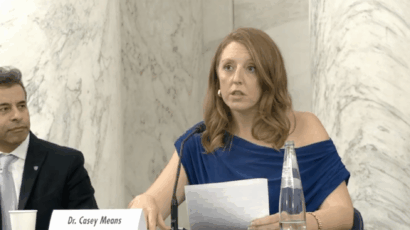Climate change, irreversibility, and urgency
By Richard C. J. Somerville | August 13, 2012
Climate scientists like to think of themselves as wise planetary physicians, explaining to the world what they have learned about climate and advising humanity on how to cope with the challenge of climate change. This metaphor can also appear attractive to policymakers and the public. Consider the appealing similarities between deciding what you should do about your weight and what the world should do about global warming. You can ask your doctor’s opinion, but it is you who will determine your target weight. You can also ask your physician to recommend actions to reach that target. You can then experiment with diet and exercise, evaluate the results, and make changes. Throughout the process, you are in charge, and the physician’s role is simply to advise.
There are obvious parallels with the climate change issue. Instead of body weight, the global average temperature at the surface of the Earth is the main metric. In place of your physician, the world has the combined expertise of the global community of climate scientists, as assessed by national academies of science and the Intergovernmental Panel on Climate Change. Deciding what climate change policies to adopt is up to the governments of all nations. Their first task is to decide how much global warming they regard as tolerable. Governments have scientific input, but they will also take into account risk tolerance, national priorities, economic impacts, and political considerations.
Suppose the world’s governments could eventually manage to agree on a specific aspirational goal, such as limiting global warming to 2 degrees Celsius (3.6 degrees Fahrenheit) above the average temperature of the mid-1800s, a time before human activities had begun to affect the global climate significantly. Governments could next ask climate scientists what reductions in the emission rates of carbon dioxide and other heat-trapping gases would be needed to meet the 2 degree Celsius target. Then governments could negotiate with one another, aiming for a binding international agreement, with specific and enforceable emission-reduction levels and timetables for all countries. Science will thus have informed this process, but governments will have made all the policy decisions.
Can this approach succeed? Some environmental challenges have followed this script faithfully. One example is the apparently successful attempt to limit stratospheric ozone loss caused by manmade chemicals such as chlorofluorocarbons. Scientific research established the cause of the ozone loss. Then the political process — with substantial scientific input — quickly led to the Montreal Protocol and subsequent international agreements to halt the manufacture of ozone-depleting chemicals. This paradigm is often cited as a role model for limiting climate change to moderate levels.
The stratospheric ozone story unfolded quickly. The key scientific paper predicting ozone loss due to chlorofluorocarbons appeared in 1974, the discovery of severe Antarctic ozone depletion was published in 1985, and the Montreal Protocol entered into force in 1989. The international community, however, has already taken much longer, both scientifically and politically, to come to grips with the climate change issue, and the doctor’s advice for dealing with the malady cannot be ignored much longer. A failure to reduce carbon dioxide emissions significantly and soon — soon being within a decade or so — will have large adverse effects that are, because of the physics and biogeochemistry of the climate system, essentially irreversible on human time scales. This is not an ideological or political assertion but an unavoidable consequence of a simple reality: Once excess carbon dioxide is added to the Earth’s atmosphere, much of it will remain there for centuries or longer before natural processes remove it.
A century and a half of greenhouse gas research. Careful laboratory experiments by the Irish physicist John Tyndall, published in 1861, showed that water vapor, carbon dioxide, and certain other gases strongly absorb infrared radiation. Tyndall was the first to put the greenhouse effect on a firm empirical foundation, and he immediately recognized the potential implications for climate change.
In 1896, the Swedish chemist Svante Arrhenius calculated the sensitivity of climate to atmospheric carbon dioxide, asking how much global mean temperature would change if atmospheric amounts were doubled or halved. Through deep physical insight plus some good luck, Arrhenius obtained a result that is within about a factor of two of modern estimates.
In hindsight, it is easy to see that mankind had clear early warning about the need to rapidly reduce emissions of heat-trapping gases in order to avoid climate disruption. In the 1970s, two Swiss scientists carried out research that anticipated the challenge now confronting policymakers. Hans Oeschger and his doctoral student, Ulrich Siegenthaler, were pioneers in the development of Earth system models. Their 1978 paper in Science, based on simple models and limited data, concluded that, “For a prescribed maximum increase of 50 percent above the pre-industrial carbon dioxide level, the production [of carbon dioxide emissions] could grow by about 50 percent until the beginning of the next century, but should then decrease rapidly.” They were right. The most recent research, with vastly better data and models incorporating a far more complete understanding of the climate system, has refined the quantitative conclusions and confirmed that essential result.
The political process, by contrast, has been extremely slow. The Earth Summit held in Rio de Janeiro in June 1992 was attended by more than 100 heads of nations and was widely praised as a landmark in environmental statesmanship. This conference produced the United Nations Framework Convention on Climate Change, a treaty signed by nearly every country on Earth. The objective of the treaty is to stabilize the amount of greenhouse gases in the atmosphere “at a level that would prevent dangerous anthropogenic interference with the climate system.” Deciding what that “dangerous” level should be, however, is a task that the Rio negotiators left for the future.
Some 20 years later, most governments have now converged on a working definition of “dangerous.” These governments have agreed that limiting the increase in the average surface temperature of the Earth to 2 degrees Celsius above pre-industrial levels would be a tolerable amount of global warming. Of course, this is a subjective decision, and some governments have argued for a lower and safer amount of warming. Officially, the European Union has accepted the 2 degree Celsius target as a concrete policy objective. Less formally, the Copenhagen Accord, endorsing the 2 degree goal, has been agreed to by some 141 countries, which together account for the great majority of the world’s emissions of heat-trapping gases. This agreement, reached at December 2009 negotiations in Copenhagen, is not legally binding, however, and sets no concrete targets for emissions reductions.
And it must be said that very little significant progress has occurred toward actually making the large cuts in global emissions of heat-trapping gases that would be needed to meet the 2 degree goal. In fact, the annual amount of global carbon dioxide emissions from human activities is now about 50 percent larger than in 1992. These emissions increased the amount, or concentration, of carbon dioxide in the atmosphere by 10 percent during this 20-year period. This amount is now about 40 percent higher than it was in the mid-1800s. It is also an observed fact that the world has already warmed by about 0.8 degrees Celsius relative to the mid-1800s. That is nearly half the magnitude of warming judged to be tolerable by the Copenhagen Accord. Meanwhile, research and recent observations of the changing climate have shown that the effects of a 2 degrees Celsius warming may be far more disruptive than had earlier been thought. For example, in the range of 1 to 2 degrees Celsius warming, the area burned by wildfire in parts of western North America is expected to increase by a factor of two to four for each degree of warming. Other climate consequences in this range of seemingly moderate warming include large changes in precipitation, increases in extreme weather events, losses in food production, rises in sea level, reductions in stream flow in many river basins, and losses of Arctic sea ice.
A sobering outlook. Recent research indicates that the climate in coming decades and centuries will be largely determined by human activities. The natural factors that have led to large climate changes in the distant past, such as changes in solar luminosity and in the Earth’s orbit, obviously still exist. These natural factors are simply too weak and too slow, however, to be significant over time scales of decades to centuries. On these time scales, human activities will dominate over natural factors. In particular, carbon dioxide is by far the most important heat-trapping gas produced by human activities, and the connection between atmospheric carbon dioxide amount and climate, while extremely complex in its details, can be summarized as follows: Substantial fractions of the carbon dioxide emitted into the atmosphere by human activities will remain in the atmosphere for centuries or longer. During that time, the carbon dioxide will become well-mixed by the winds, so that for climate purposes, the carbon dioxide concentration has effectively the same value everywhere on Earth. Even in the inconceivable event that emissions were to suddenly stop completely, the climate changes caused by carbon dioxide would persist for very long periods of time. The cumulative amount of carbon dioxide emitted by human activities since the industrial revolution of the 1800s will largely determine the magnitude of the resulting climate change. For any specific target limit to global warming, such as 2 degrees Celsius, there is thus an allowed total amount of cumulative carbon dioxide emissions that must not be exceeded.
The quantitative implications of this scientific understanding are sobering. They confirm the 1978 insights of Siegenthaler and Oeschger. If global emissions of heat-trapping gases were to continue at current rates for the next 20 years, and then immediately cease entirely, the cumulative emissions will have exceeded the best estimate of the allowed amount, so the likelihood of meeting the 2 degree Celsius target would be low. Instead, in order to limit warming to 2 degrees Celsius, global emissions need to peak very soon, between now and about 2020, and then must decline rapidly. To stabilize climate, an almost completely decarbonized global world — with near-zero emissions of carbon dioxide and other long-lived greenhouse gases — needs to be achieved well within this century. More specifically, the average annual per-capita emissions will have to shrink to well below one metric ton of carbon dioxide by 2050. This is about 80 to 95 percent below the per-capita emissions in developed nations in 2000.
The climate system dictates a timescale for action. Decisions made by governments early in this century will have long-term consequences for the climate. Failure to take meaningful actions to reduce global emissions is a particularly serious decision. By continuing on its current path of increasing global carbon dioxide emissions, humanity is committing future generations to a strongly altered climate. Even beyond the current century, there are major implications for longer-term climate change. Higher temperatures and accompanying changes in climate caused by carbon dioxide emissions from human activity will be largely irreversible on human time scales. The effects are long-lasting. Atmospheric temperatures are not expected to begin to decrease substantially for many centuries to millennia, even after human-induced greenhouse gas emissions stop completely.
To meet the 2 degree Celsius target, the climate system itself thus imposes a timescale on when emissions need to peak and then begin to decline rapidly. Scientific understanding of this timescale shows that mitigation of climate change is urgent and cannot wait. A window of opportunity to decrease emissions has been open for several decades but will soon close and will remain closed. This urgency is thus not ideological or political, but rather is due to the long residence time of atmospheric carbon dioxide and the resulting near-irreversibility of climate change for centuries or longer. This is a critical shortcoming of the medical metaphor that likens the climate change problem to the task of an individual trying to reach a target body weight. If your current weight is higher than your target, medical science can advise you on how to lose weight. If the amount of carbon dioxide in the atmosphere becomes higher than the amount compatible with the desired limit on global warming, however, the warming will exceed the target. There is no proven technology for removing large amounts of carbon dioxide from the atmosphere economically.
In short, the urgency of acting to mitigate climate change is directly linked to the physics and biogeochemistry of the climate system. An enduring failure to achieve meaningful science-based international agreements to rapidly reduce emissions of heat-trapping gases will inevitably have serious consequences for the degree of climate change that the Earth will undergo. If the world as a whole continues to procrastinate throughout the current decade, allowing emissions to continue to increase year after year, then it will almost certainly have lost the opportunity to limit warming to 2 degrees Celsius. Instead, our children and their descendants, and ultimately all living things, will be faced with the consequences of more severe climate disruption.
Together, we make the world safer.
The Bulletin elevates expert voices above the noise. But as an independent nonprofit organization, our operations depend on the support of readers like you. Help us continue to deliver quality journalism that holds leaders accountable. Your support of our work at any level is important. In return, we promise our coverage will be understandable, influential, vigilant, solution-oriented, and fair-minded. Together we can make a difference.
Topics: Climate Change, Opinion















